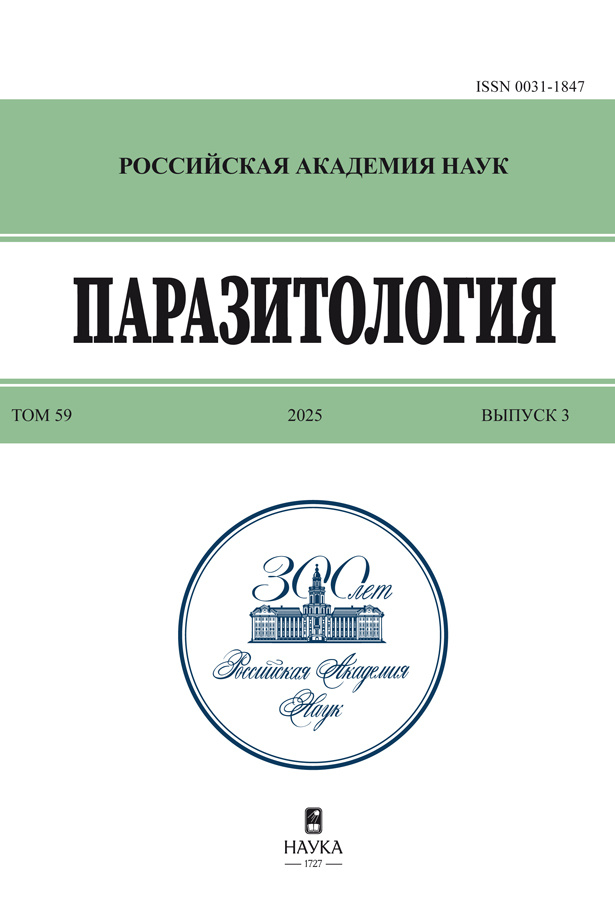Male longevity in Aedes (Ochlerotatus) communis (de Geer) and A. (O.) cantans (Meigen) (Diptera, Culicidae) reared from embryos in laboratory conditions
- Autores: Razygraev A.V.1
-
Afiliações:
- Zoological Institute of the Russian Academy of Sciences
- Edição: Volume 59, Nº 3 (2025)
- Páginas: 215-223
- Seção: Articles
- URL: https://journal-vniispk.ru/0031-1847/article/view/326342
- DOI: https://doi.org/10.31857/S0031184725030020
- EDN: https://elibrary.ru/SXHGBI
- ID: 326342
Citar
Resumo
Adult longevity in male mosquitoes Aedes (Ochlerotatus) communis (de Geer) and A. (O.) cantans (Meigen), reared from embryos in laboratory, was estimated. These two species were also compared with each other by the duration of development from egg hatching to adult emergence. Eggs (developed embryos, already passed through the diapause) were collected with fallen leaves and pieces of soil from under the snow at the edge of the pond, where large quantities of larvae of these species were spotted in the previous spring. A loose mass of fallen leaves and ground (1 L), containing mosquito eggs, was placed in a 10-L enamel container with cold (4°C) tap water. Water temperature gradually increased up to 21-22°С during several hours. After 2 days of incubation, water with hatched larvae was transferred to a new 10-L enamel container, while the most part of leaves and soil was removed. In this water, at 21-22°С and natural light regimen (during February-March at 59°51'N), larvae developed to pupae. Emerged adults were reared in groups in specially constructed transparent plastic containers with free access to sucrose and water, with mean environmental temperature 22.4°С, 50% air humidity inside containers, and natural light regimen. It was revealed that A. communis develops faster and emerges earlier than A. cantans: emergence of male A. communis and A. cantans started after 11.5 and 13 days, respectively, from the placement of the embryos in water, and lasted no more than 2.5 and 3 days, respectively. Adult longevity in males of A. communis was, in general, shorter than that in males of A. cantans: median values were 7.5 and 20 days for male A. communis and A. cantans, respectively. The results demonstrate that A. cantans males are more convenient for prolonged experiments under laboratory conditions than males of A. communis. Comparisons of present results with the previous data suggest that adults of A. cantans reared from embryos in a laboratory are, in general, not less viable than their conspecifics hatched and developed in pre-imaginal stages in natural conditions, and that there are differences in longevity in adult male A. cantans reared from different samples of embryos.
Palavras-chave
Sobre autores
A. Razygraev
Zoological Institute of the Russian Academy of Sciences
Autor responsável pela correspondência
Email: a.v.razygraev@gmail.com
St. Petersburg, 199034
Bibliografia
- Медведев С.Г., Айбулатов С.В., Панюкова Е.В. 2010. Экологические особенности и распространение комара Aedes communis (De Geer, 1776) на территории Северо-Запада европейской части России. Паразитология 44 (5): 441-460.
- Разыграев А.В. 2022. О продолжительности жизни хаоборид (Diptera, Chaoboridae) при углеводном питании. Энтомологическое обозрение 101(2): 207-216. https://doi.org/10.31857/S0367144522020010
- Разыграев А.В. 2023. О высокой устойчивости к кратковременному промерзанию у зимующих комаров Culex territans Walker (Diptera, Culicidae). Энтомологическое обозрение 102(2): 241-248. https://doi.org/10.31857/S0367144523020041
- Разыграев А.В. 2024. Продолжительность жизни самцов и самок Aedes (Ochlerotatus) cantans (Meigen) и A. (O.) communis (de Geer) (Diptera, Culicidae). Энтомологическое обозрение 103(3): 291-300. https://doi.org/10.31857/S0367144524030015
Arquivos suplementares









